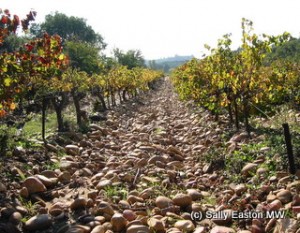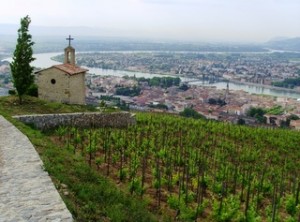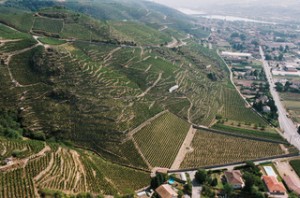Syrah in France
A version of this article first appeared in Australia’s Winestate magazine, Sept/Oct 2009.
Bordeaux may get all the headlines, but there’s more syrah planted in France than cabernet sauvignon. The Rhône valley has all the famous, top-notch vineyards, but they are tiny in comparison to total plantings, which are widespread across the whole south of France, where syrah is normally blended with grenache, plus cinsault, mourvèdre (mataro) and carignan.

Rhône valley vineyard
Things are quite regulated in the Rhône valley. And the northern Rhône is tiny in comparison to the southern Rhône. The northern ‘crus’ appellations including Cornas, Côte-Rôtie, Crozes-Hermitage, Hermitage and St. Joseph account for only 5% of total Rhône valley production.
The rest is from the broad rolling terrain of the southern Côtes du Rhône and Côtes du Rhône-Villages appellations as well as the likes of Châteauneuf-du-Pape, Gigondas and Vacqueyras.
In total, France has about 70,000 ha of syrah spread over all these regions, compared to Australia’s 44,000. But this is just 8.5% of the vineyard area in France whereas Australia has made a massive feature of shiraz, which accounts for more than a quarter of the country’s total vineyard area.
At the crème-de-la-crème end of syrah wine, Côte-Rôtie vies with Hermitage for top dog slot, and it’s often personal preference. They’re on different sides of the river, the ‘roasted slopes’ of Côte-Rôtie face the warm east and south, and the appellation allows the use of viognier in the blend, something that’s also become very trendy in Australia. Meanwhile Hermitage is considered more muscular and tannic, the slopes face mostly west and south, and the wines must be made 100% of syrah. The total production of these two appellations combined is in the region of 160,000 cases. Rarity value alone stretches the imagination.
The Hermitage appellation, at just 130 ha, is a hard, granite hill, an outcrop from France’s Massif Central, separated from it by the River Rhône. The river was forced to take a nearly west-east squiggle past the 344m high hill on its way south to the Mediterranean sea. The west sides, those facing across the river to the Massif, are therefore all granite-based soils. On the east side of the hill, soil influences come more from the Alps, with glacial deposits.

Jaboulet Hermitage
One of the most iconic Hermitage wines is Jaboulet’s La Chapelle. This chapel of Saint Christopher has been owned by Maison Paul Jaboulet Aîné since 1919. Caroline Frey, their winemaker said: ”one of the particularities of La Chapelle is to blend all the different terroirs of Hermitage – Méal, Bessard, Rocoules, Murets – that’s why the wine is so complex and so well balanced, with such a long ageing potential.”
Michel Chapoutier, the seventh generation to run his eponymous business, whose L’Ermite wine is also from Hermitage added, with “the same grape you have different expressions in different soils – the granite part of Hermitage is graphite dominant, in Méal, you get ink.” On this basis a winemaker can choose whether to blend different parcels, as in La Chapelle, or create a unique expression of a single vineyard site, as in L’Ermite.
Other appellations also have different expressions, he said: “Côte-Rôtie gives black olive and bacon, Cornas is fig leaves.” Chapoutier didn’t restrict his comments to France; he also works in Australia and said of his projects there “the Cambrian rock at Heathcote gives a concentration with ink and violet [and] in the Pyrenees, on schist, it is liquorice and pepper. Even with same clone, we have different expressions thanks to soil.” Terroir, or site-specificity clearly influences syrah’s flavours.
Côte-Rôtie is a little bigger than Hermitage, but still only musters 224 ha in total. It’s generally less tannic, and the best are more floral, fragrant and elegant than Hermitage. Guigal is one of the best regarded proponents of the appellation, and his single vineyard wines La Mouline, La Turque and La Landonne are some of the most sought-after wines.

Guigal Côte Blonde
Philippe Guigal, general manager and winemaker at E. Guigal took up the terroir theme for syrah in the northern Rhône. In terms of quality, he said: “high quality parameters are the vineyard and terroir, and the people behind the terroir. We have a lot of winemakers who counterbalance what is normally done by terroir and nature. On the Côte Blonde, we expect very fine, delicate wines. Brune has more tannins, more structure.” He said some winemakers might do more pumping over on Blonde fruit to counter its delicacy, But at Guigal he added, the “balance is the opposite: if the terroir says the wine should be fine and delicate, we want to keep the level of finesse and delicacy. And to keep the phenolic potential of Brune.” Their ‘Blonde et Brune’ Côte-Rôtie is a blend of fruit from these two vineyards. And the Guigal vineyards are co-planted with a tiny percentage of viognier, as permitted in the regulations. It is all picked at the same time and fermented together with the shiraz.
Given that the northern Rhône appellations account for just 5% of total Rhône production, it is no surprise that the main producers also run merchant businesses in the southern Rhône, buying in fruit and wine, blending it and bottling under their own label, for each appellation. In this respect it’s no different from the bigger Australian companies buying fruit in several regions. Guigal’s Côtes du Rhône is probably one of the best known brands. Philippe Guigal said: “we taste blind finished samples on a large scale. Every day [after harvest] we receive 50-60 samples and we select one or two each time. 90% of the time, we buy wine from the same people” even though the wines are tasted blind, which shows both the consistency of the tasting and of the growers.
There are more than 6,000 wine growers in the Rhône Valley, so this type of business is important for Rhône brands. The big southern Côtes du Rhône appellation has different regulations again, and here syrah is a contributor to the blend, which contains grenache, as well as mourvèdre. Syrah adds berry fruits, structure and some fine tannins to a Côtes du Rhône blend. Guigal’s usually has at least 50% syrah, and more in poorer vintages to preserve the structure, while Jaboulet’s Parallèle 45 is usually around 60% grenache with 40% syrah.
But it’s not just the bigger players that run their business as a combination of estate and merchant sectors. Château Mont-Redon started out as a Châteauneuf-du-Pape estate. But since the mid 1990s, said owner Jean Abeille “we conduct two different activities – producer with a wine range under the ‘Château Mont-Redon’ label and wine merchant activity under the ‘Monredon’ brand.” This keeps estate separate from brand, but more than hints at the link. He said they started partly as a response to customer demand and also for their children who will one day inherit the business.
So just in the Rhône valley, the wines may be 100% syrah, in the north, or 10% or more in a Côtes du Rhône blend – the original GSM (grenache, syrah/shiraz, mourvèdre) wines. There’s also plenty of syrah planted in the Roussillon and Languedoc, all across the regions that border the warm Mediterranean Sea, offering syrah a climate that makes it smile.



